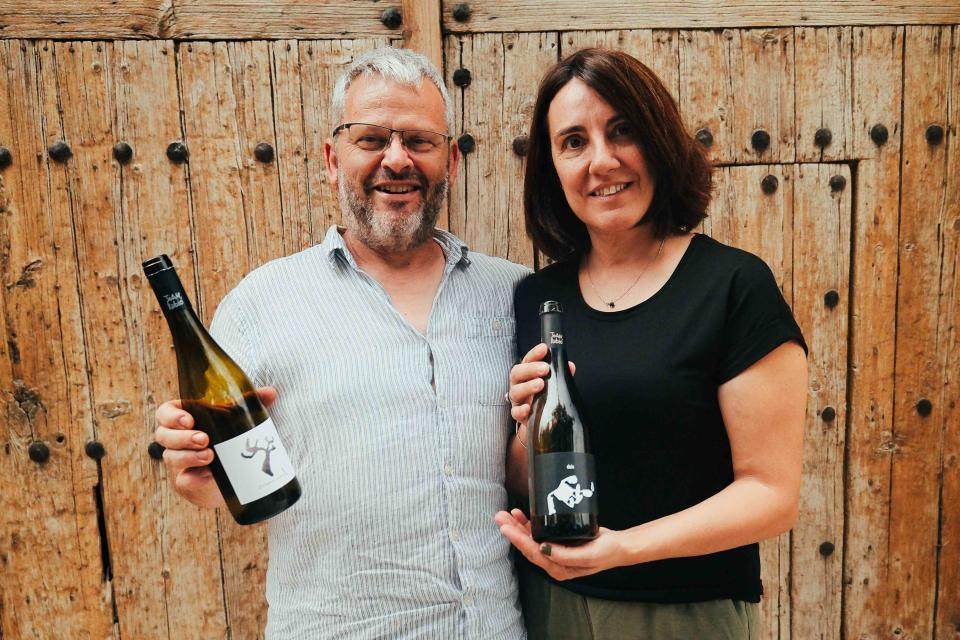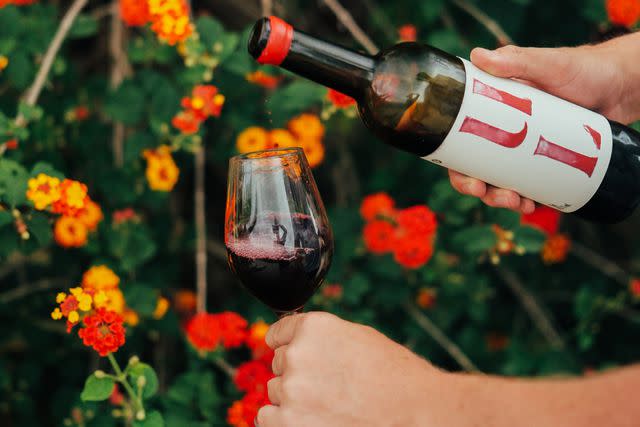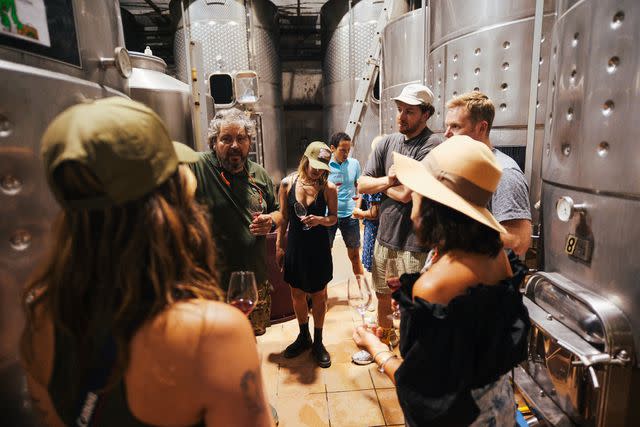Champagne and Prosecco Drinkers — This Spanish Wine Region Makes Bubbly You'll Love
In a shift away from Cava, pioneer winemakers are shaking up — and defining — the “new” Catalonia.

Courtesy of Viniesta
For centuries, Cava has claimed a top place as Spain's signature sparkling wine. It’s the driving factor behind winemaking in Penedès, the largest wine-producing region in Catalonia, south of Barcelona, and one of the oldest wine regions in Europe.
Generations of families have grown and sold Cava’s trinity of Macabeo, Parellada, and Xarel-lo to big-name producers like Freixenet and Codorníu. But as the natural wine movement continues to gain traction in Spain, up-and-coming vineyard owners are taking their family estates in new directions, transitioning from grape growing to winemaking.
“My father is the last of his kind, bent over at 75 years old in the vines,” says Rubén Parera, a fourth-generation farmer and proprietor of Finca Parera, who converted his family’s 25-acre estate to biodynamic farming. “I’m now the ‘new’ farmer.” Using the same Xarel-lo and Chardonnay grapes his father previously sold to Freixenet, he now produces the slightly fizzy house pétillant naturel (pét-nat) for his wine bar Salvatge, in Barcelona.
Small, independent producers like Parera aren’t just shying away from working with major Cava houses — they’re shifting away from Cava altogether. They’re focusing on other styles of sparkling wine, like pét-nats or ancestrales, which are crafted in the traditional Champagne method, and experimenting with native, niche grapes. These include Trepat, a red grape with a bright, tart cherry-like profile, which has been growing in popularity over the past decade to use for varietal still wine rather than just blended into Cava.
Related: How to Find the Best Wines from Spain
“You’re starting to see a lot more diversity in the region as winemakers are recovering old varieties that some of these big wine producers abandoned because they were looking for easy, marketable international varieties like Cabernet Sauvignon,” says Alvaro de la Viña, owner of Selections de la Viña, which imports wines from more than 50 producers across the Iberian Peninsula, as well as the founder of Viniesta, which hosts annual natural wine-focused fairs and wine trips to Spain.
Also exemplifying this trend is Joan Rubió. After spending 15 years as a winemaker at Cava producer Recaredo, Rubió now crafts sparkling Ancestral Xarel-lo — only 3,000 bottles of which are produced annually — at Cal Tiques, his home and winery located at the family’s vineyard in Alt Penedès. “These winemakers are taking power from the big houses, which have been preventing the region from moving forward, says de la Viña. “Now it’s almost like Catalonia is recovering its own identity.”
Reviving native grapes
About 20 years ago, Sumoll, the “Pinot Noir of the Mediterranean,” was borderline extinct. Pre-phylloxera, the drought-resistant, native black grape variety was the most widely planted in the region. Since winemakers realized Sumoll could be the solution to dry vintages, as well as the future of Catalan bubbles, there’s been a resurgence.
“Sumoll was unauthorized to make Cava until recently, and producers like Manel Aviñó, of Close Lentiscus, are using the grape to make sparkling wines the same way Pinot Noir is used in Champagne,” says de la Viña. He considers Aviñós 14th-century family estate’s 100% Sumoll Blanc de Noirs Brut Nature as one of the most representative of Catalonia’s current wine landscape.

Courtesy of Viniesta
Nicknamed the “Bubble Man,” Aviñó (whose fan base includes musician Dua Lipa) works alongside his daughter, Núria, giving her a voice and space to make her own wines.
“Our region, it’s in a constant process of evolution,” he says. “The new producers have been following our path, but have their own style of expression. Clean wine is the best way to fight climate change, so I think that it’s really important to grow a strong community that respects and follows this principle.”
Throughout Catalonia, where vineyards may be planted from nearly 2,300 feet in elevation near the edge of the Pyrenees mountains, all the way down to sea level along the Mediterranean coast, winemakers’ stories echo one another.
“All of the plots I have are surrounded by forests, so when I cleared the brush to create a vineyard, people said, ‘What are you doing here?’” says Salvador Batlle Barrabeig, proprietor of Còsmic Vinyaters and a proponent of local Garnacha and Carinyena Blanca (Carignan Blanc). “I didn’t know anything about this area, but sometimes something magical happens if you follow your intuition. I don’t want to make a wine I don’t feel comfortable with just because the market is demanding it.”
How wine bars are setting the stage for Spanish sparkling
At the speakeasy-style tapas restaurant El Cup Vell in Tarragona, the wine list champions some of these smaller, independent winemakers with bottles like Mas Gomà’s El Mural, a single-vineyard Parellada Brut Nature, Vega Aixalà’s Albariño-based sparkling Emma Ancestral, and Celler Tuets’s Trepat Ancestral Rosé. At Bar Cortijo, known for carrying the widest selection of natural wines from around Tarragona, you’ll find selections like Chardonnay-based Niu Celler’s La Pastorella, which pairs beautifully with the eatery’s signature tripe and croquettes.
“These winemakers are taking power from the big houses, which have been preventing the region from moving forward, says de la Viña. “Now it’s almost like Catalonia is recovering its own identity.”
At Parera’s wine bar MAM del BO, across the street from Finca Parera in the town of Sant Llorenç d'Hortons, the winery’s limited-production light-red Fins Als Kullons — a blend of Sumoll, Xarel-lo, and Garnacha Blanca — is served from a traditional spouted glass porrón, which has been a fixture in Catalan culture for centuries.
“The most exciting part about the region is seeing how they’re not only honoring native varieties, they’re doing what makes the most sense for the climate we’re in, [and] wines that are going to thrive under these conditions,” says Macarena “Maca” Carrillo, co-owner of wine pop-up Grape Crush and head sommelier at Michelin-starred Korean steakhouse COTE Miami. “As they keep working with these grapes, the wines are going to get better and better.”

Courtesy of Viniesta
Massimo Marchiori, half of the Italian husband-wife duo behind Partida Creus, started their winery as a passion project that kickstarted a second life for the couple. “Now we’re old but happy,” joked his wife, Antonella Gerosa. She adds that their first love in the area was Sumoll, which spurred a deep dive down the native grape rabbit hole.
The couple has spent almost 25 years investing in the recovery of ancient grape varities and old vines in neglected vineyards across Baix Penedès to create wines like their wildly popular VN Vinel.Lo Tinto field blend, crafted from seven native grapes: Trepat, Sumoll, Garrut (Mourvedre), Queixal de Llop, Ull de Perdiu, Garnacha, and Samsó (Carignan).
“They became so successful in growing ancestral varieties that others started following their path,” says de la Viña. “Sometimes you need someone from the outside to come in and show you the value of what’s yours."
For more Food & Wine news, make sure to sign up for our newsletter!
Read the original article on Food & Wine.

 Yahoo Lifestyle
Yahoo Lifestyle 
